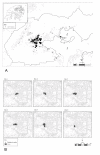Surveillance of febrile patients in a district and evaluation of their spatiotemporal associations: a pilot study
- PMID: 20170529
- PMCID: PMC2831836
- DOI: 10.1186/1471-2458-10-84
Surveillance of febrile patients in a district and evaluation of their spatiotemporal associations: a pilot study
Abstract
Background: Fever is an undifferentiated clinical feature that may enhance the sensitivity of syndromic surveillance systems. By studying the spatiotemporal associations of febrile patients, it may allow early detection of case clustering that indicates imminent threat of infectious disease outbreaks in the community.
Methods: We captured consecutive emergency department visits that led to hospitalization in a district hospital in Hong Kong during the period of 12 Sep 2005 to 14 Oct 2005. We recorded demographic data, provisional diagnoses, temperature on presentation and residential location for each patient-episode, and geocoded the residential addresses. We applied Geographical Information System technology to study the geographical distribution these cases, and their associations within a 50-m buffer zone spatially. A case cluster was defined by three or more spatially associated febrile patients within each three consecutive days.
Results: One thousand and sixty six patient-episodes were eligible for analysis; 42% of them had fever (>37 degrees C; oral temperature) on presentation. Two hundred and four patient-episodes (19.1%) came from residential care homes for elderly (RCHE). We detected a total of 40 case clusters during the study period. Clustered cases were of older age; 57 (33.3%) were residents of RCHE. We found a median of 3 patients (range: 3 - 8) and time span of 3 days (range: 2 - 8 days) in each cluster. Twenty five clusters had 2 or more patients living in the same building block; 18 of them were from RCHE.
Conclusions: It is technically feasible to perform surveillance on febrile patients and studying their spatiotemporal associations. The information is potentially useful for early detection of impending infectious disease threats.
Figures
Similar articles
-
Cluster Detection Mechanisms for Syndromic Surveillance Systems: Systematic Review and Framework Development.JMIR Public Health Surveill. 2020 May 26;6(2):e11512. doi: 10.2196/11512. JMIR Public Health Surveill. 2020. PMID: 32357126 Free PMC article.
-
Self-reported fever and measured temperature in emergency department records used for syndromic surveillance.J Am Med Inform Assoc. 2012 Sep-Oct;19(5):775-6. doi: 10.1136/amiajnl-2012-000847. Epub 2012 May 17. J Am Med Inform Assoc. 2012. PMID: 22596079 Free PMC article.
-
A diagnostic and epidemiologic investigation of acute febrile illness (AFI) in Kilombero, Tanzania.PLoS One. 2017 Dec 29;12(12):e0189712. doi: 10.1371/journal.pone.0189712. eCollection 2017. PLoS One. 2017. PMID: 29287070 Free PMC article.
-
Observing the spread of common illnesses through a community: using Geographic Information Systems (GIS) for surveillance.J Am Board Fam Med. 2010 Jan-Feb;23(1):32-41. doi: 10.3122/jabfm.2010.01.090137. J Am Board Fam Med. 2010. PMID: 20051540
-
Real-time syndrome surveillance in Ontario, Canada: the potential use of emergency departments and Telehealth.Eur J Emerg Med. 2004 Feb;11(1):3-11. doi: 10.1097/00063110-200402000-00002. Eur J Emerg Med. 2004. PMID: 15167186 Review.
Cited by
-
Cluster Detection Mechanisms for Syndromic Surveillance Systems: Systematic Review and Framework Development.JMIR Public Health Surveill. 2020 May 26;6(2):e11512. doi: 10.2196/11512. JMIR Public Health Surveill. 2020. PMID: 32357126 Free PMC article.
-
Self-reported fever and measured temperature in emergency department records used for syndromic surveillance.J Am Med Inform Assoc. 2012 Sep-Oct;19(5):775-6. doi: 10.1136/amiajnl-2012-000847. Epub 2012 May 17. J Am Med Inform Assoc. 2012. PMID: 22596079 Free PMC article.
References
-
- Heffernan R, Mostarshari F, Das D, Karpati A, Kulldorff M, Weiss D. Syndromic surveillance in public health practice, New York City. Emerg Infect Dis. 2004;10(5):5237–5240. - PubMed
-
- Hope K, Durrheim DN, Muscatello D, Merritt T, Zheng W, Massey P, Cashman P, Eastwood K. Identifying pneumonia outbreaks of public health importance: can emergency department data assist in earlier detection? Aust N Z J Public Health. 2008;32(4):361–363. doi: 10.1111/j.1753-6405.2008.00255.x. - DOI - PubMed
Publication types
MeSH terms
LinkOut - more resources
Full Text Sources
Medical



